Construction Economics: NPD Model and PFI Comparison Report
VerifiedAdded on 2020/04/13
|15
|3525
|103
Report
AI Summary
This report provides a comprehensive analysis of the Non-Profit Distribution (NPD) Model in construction economics, contrasting it with the traditional Private Finance Initiative (PFI) Model. The study focuses on the application of the NPD Model within the construction industry of Scotland, examining its core principles, including the unique approach to investment returns where investors receive pre-decided amounts rather than equity-based dividends, and the emphasis on stakeholder involvement. The report highlights the key differences between the NPD and PFI models, particularly in the distribution of surplus funds, with the NPD Model reinvesting surplus into community welfare. It evaluates the success of the NPD Model in Scotland, identifying factors such as its ability to attract investment, especially post-financial crisis, and the redistribution of surplus funds to benefit the community. The report also discusses the limitations of the NPD Model and suggests potential areas for improvement.
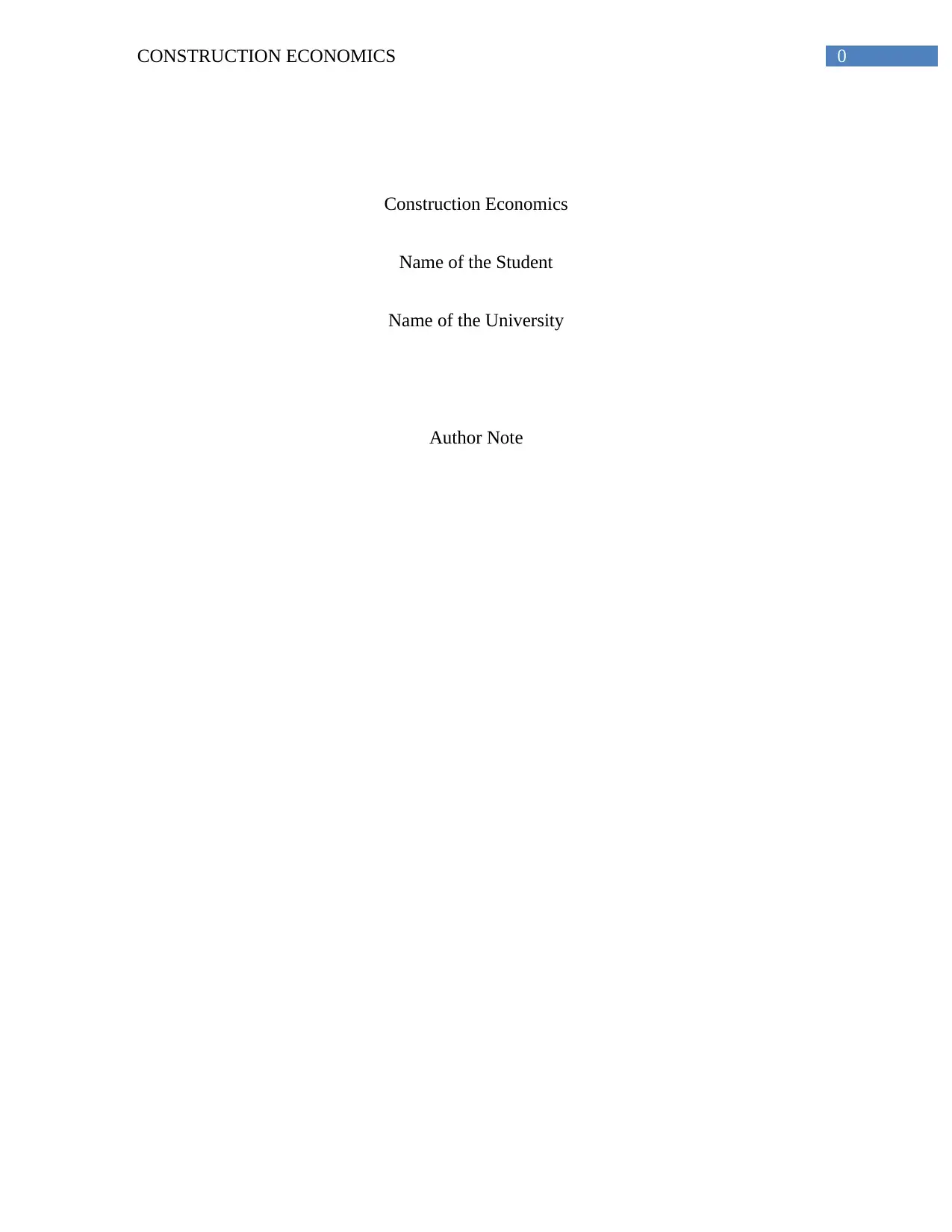
0CONSTRUCTION ECONOMICS
Construction Economics
Name of the Student
Name of the University
Author Note
Construction Economics
Name of the Student
Name of the University
Author Note
Secure Best Marks with AI Grader
Need help grading? Try our AI Grader for instant feedback on your assignments.
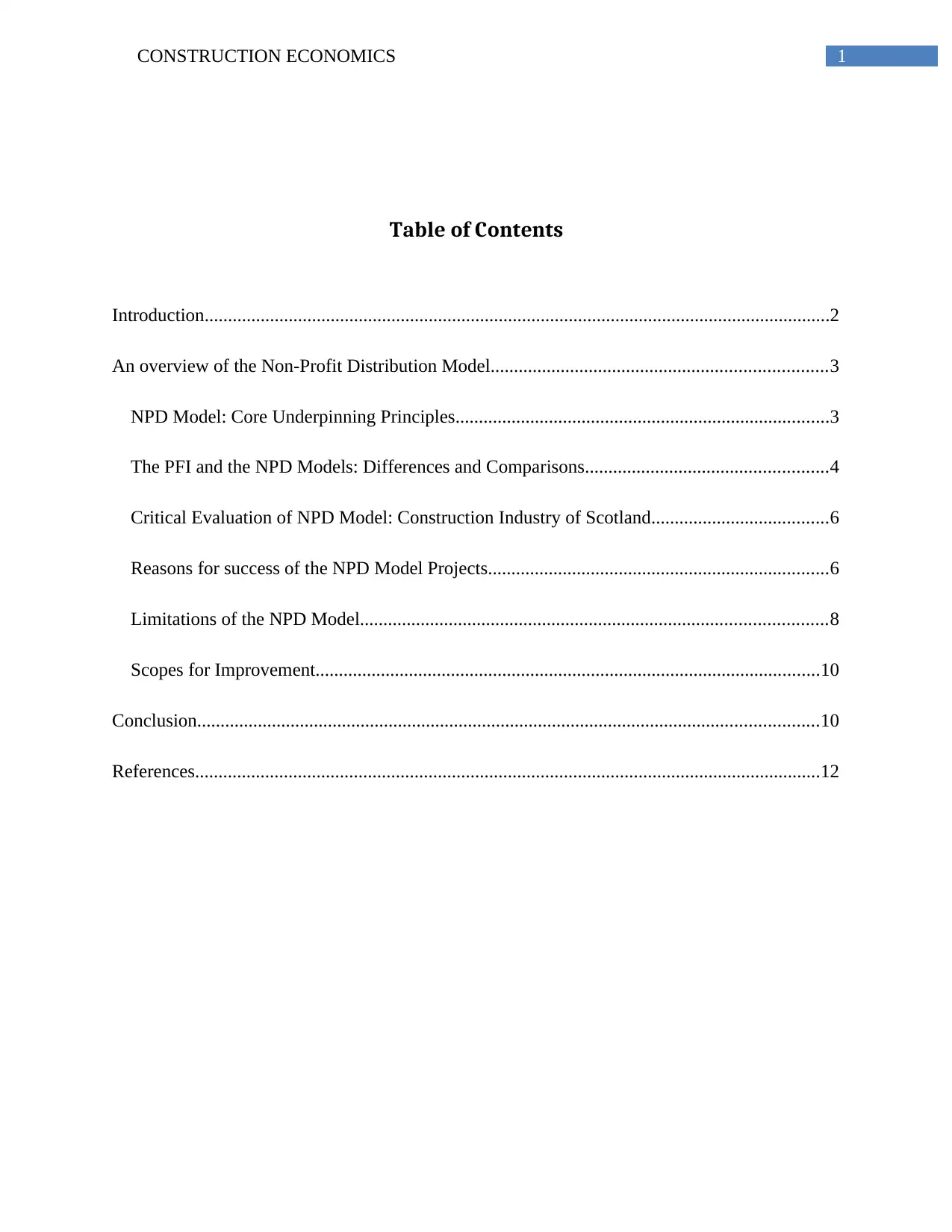
1CONSTRUCTION ECONOMICS
Table of Contents
Introduction......................................................................................................................................2
An overview of the Non-Profit Distribution Model........................................................................3
NPD Model: Core Underpinning Principles................................................................................3
The PFI and the NPD Models: Differences and Comparisons....................................................4
Critical Evaluation of NPD Model: Construction Industry of Scotland......................................6
Reasons for success of the NPD Model Projects.........................................................................6
Limitations of the NPD Model....................................................................................................8
Scopes for Improvement............................................................................................................10
Conclusion.....................................................................................................................................10
References......................................................................................................................................12
Table of Contents
Introduction......................................................................................................................................2
An overview of the Non-Profit Distribution Model........................................................................3
NPD Model: Core Underpinning Principles................................................................................3
The PFI and the NPD Models: Differences and Comparisons....................................................4
Critical Evaluation of NPD Model: Construction Industry of Scotland......................................6
Reasons for success of the NPD Model Projects.........................................................................6
Limitations of the NPD Model....................................................................................................8
Scopes for Improvement............................................................................................................10
Conclusion.....................................................................................................................................10
References......................................................................................................................................12
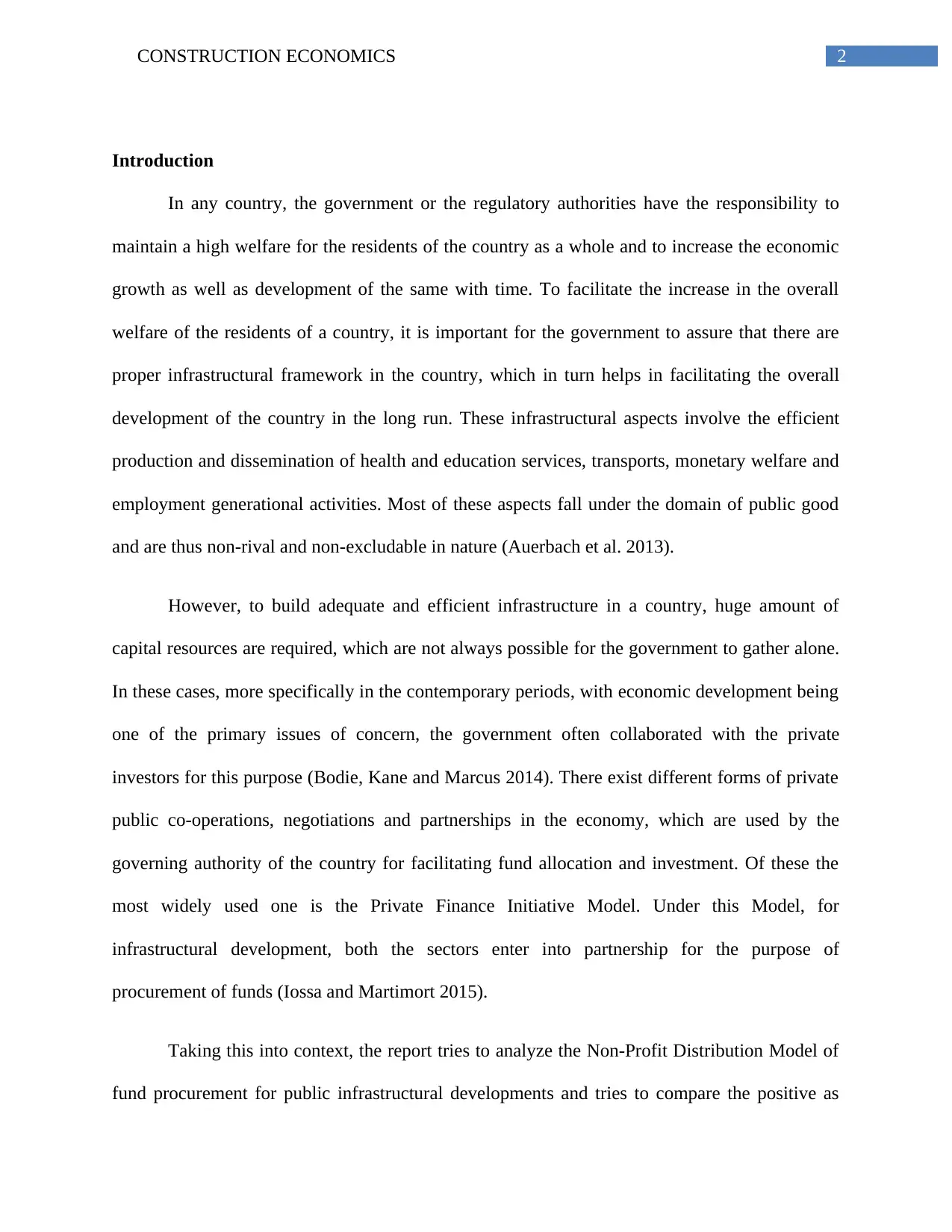
2CONSTRUCTION ECONOMICS
Introduction
In any country, the government or the regulatory authorities have the responsibility to
maintain a high welfare for the residents of the country as a whole and to increase the economic
growth as well as development of the same with time. To facilitate the increase in the overall
welfare of the residents of a country, it is important for the government to assure that there are
proper infrastructural framework in the country, which in turn helps in facilitating the overall
development of the country in the long run. These infrastructural aspects involve the efficient
production and dissemination of health and education services, transports, monetary welfare and
employment generational activities. Most of these aspects fall under the domain of public good
and are thus non-rival and non-excludable in nature (Auerbach et al. 2013).
However, to build adequate and efficient infrastructure in a country, huge amount of
capital resources are required, which are not always possible for the government to gather alone.
In these cases, more specifically in the contemporary periods, with economic development being
one of the primary issues of concern, the government often collaborated with the private
investors for this purpose (Bodie, Kane and Marcus 2014). There exist different forms of private
public co-operations, negotiations and partnerships in the economy, which are used by the
governing authority of the country for facilitating fund allocation and investment. Of these the
most widely used one is the Private Finance Initiative Model. Under this Model, for
infrastructural development, both the sectors enter into partnership for the purpose of
procurement of funds (Iossa and Martimort 2015).
Taking this into context, the report tries to analyze the Non-Profit Distribution Model of
fund procurement for public infrastructural developments and tries to compare the positive as
Introduction
In any country, the government or the regulatory authorities have the responsibility to
maintain a high welfare for the residents of the country as a whole and to increase the economic
growth as well as development of the same with time. To facilitate the increase in the overall
welfare of the residents of a country, it is important for the government to assure that there are
proper infrastructural framework in the country, which in turn helps in facilitating the overall
development of the country in the long run. These infrastructural aspects involve the efficient
production and dissemination of health and education services, transports, monetary welfare and
employment generational activities. Most of these aspects fall under the domain of public good
and are thus non-rival and non-excludable in nature (Auerbach et al. 2013).
However, to build adequate and efficient infrastructure in a country, huge amount of
capital resources are required, which are not always possible for the government to gather alone.
In these cases, more specifically in the contemporary periods, with economic development being
one of the primary issues of concern, the government often collaborated with the private
investors for this purpose (Bodie, Kane and Marcus 2014). There exist different forms of private
public co-operations, negotiations and partnerships in the economy, which are used by the
governing authority of the country for facilitating fund allocation and investment. Of these the
most widely used one is the Private Finance Initiative Model. Under this Model, for
infrastructural development, both the sectors enter into partnership for the purpose of
procurement of funds (Iossa and Martimort 2015).
Taking this into context, the report tries to analyze the Non-Profit Distribution Model of
fund procurement for public infrastructural developments and tries to compare the positive as
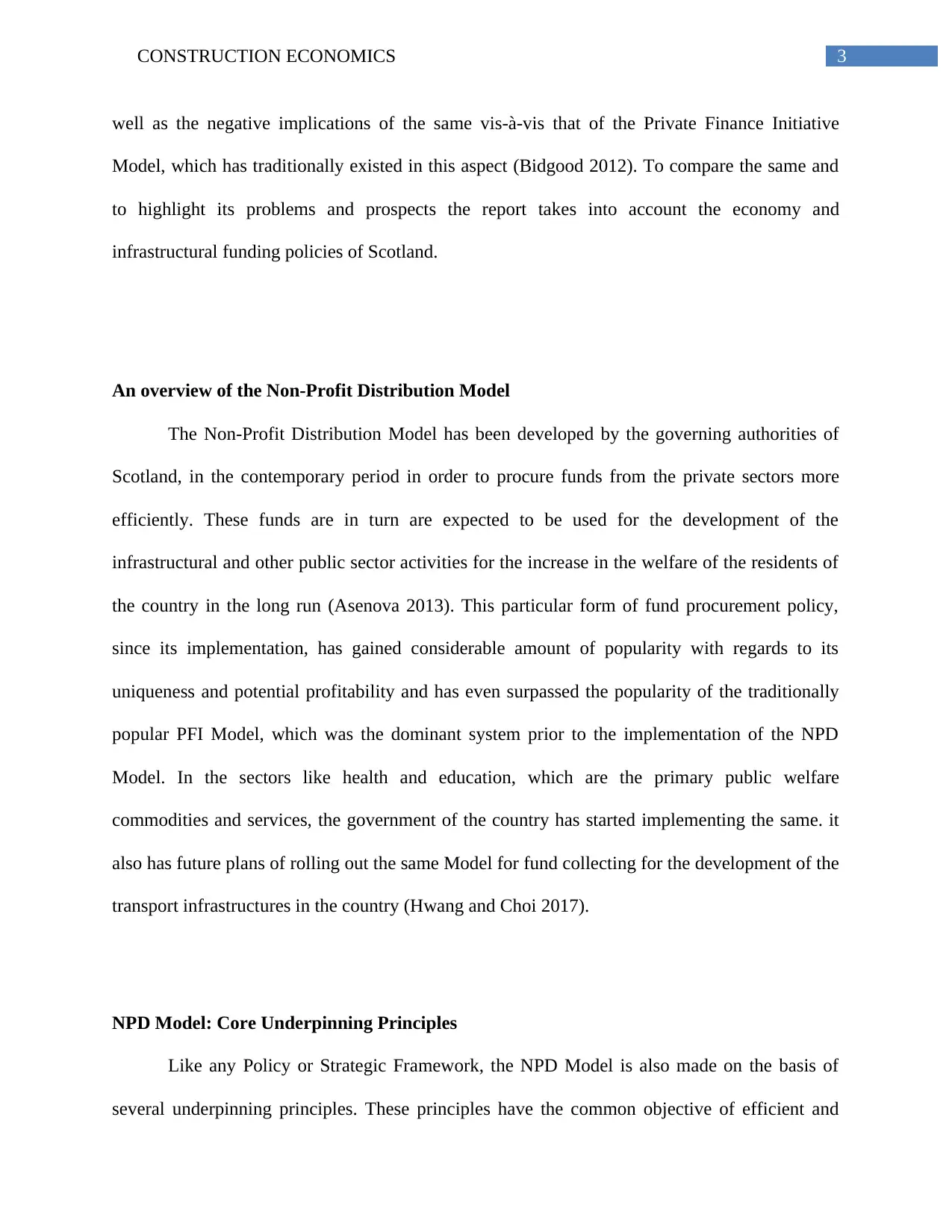
3CONSTRUCTION ECONOMICS
well as the negative implications of the same vis-à-vis that of the Private Finance Initiative
Model, which has traditionally existed in this aspect (Bidgood 2012). To compare the same and
to highlight its problems and prospects the report takes into account the economy and
infrastructural funding policies of Scotland.
An overview of the Non-Profit Distribution Model
The Non-Profit Distribution Model has been developed by the governing authorities of
Scotland, in the contemporary period in order to procure funds from the private sectors more
efficiently. These funds are in turn are expected to be used for the development of the
infrastructural and other public sector activities for the increase in the welfare of the residents of
the country in the long run (Asenova 2013). This particular form of fund procurement policy,
since its implementation, has gained considerable amount of popularity with regards to its
uniqueness and potential profitability and has even surpassed the popularity of the traditionally
popular PFI Model, which was the dominant system prior to the implementation of the NPD
Model. In the sectors like health and education, which are the primary public welfare
commodities and services, the government of the country has started implementing the same. it
also has future plans of rolling out the same Model for fund collecting for the development of the
transport infrastructures in the country (Hwang and Choi 2017).
NPD Model: Core Underpinning Principles
Like any Policy or Strategic Framework, the NPD Model is also made on the basis of
several underpinning principles. These principles have the common objective of efficient and
well as the negative implications of the same vis-à-vis that of the Private Finance Initiative
Model, which has traditionally existed in this aspect (Bidgood 2012). To compare the same and
to highlight its problems and prospects the report takes into account the economy and
infrastructural funding policies of Scotland.
An overview of the Non-Profit Distribution Model
The Non-Profit Distribution Model has been developed by the governing authorities of
Scotland, in the contemporary period in order to procure funds from the private sectors more
efficiently. These funds are in turn are expected to be used for the development of the
infrastructural and other public sector activities for the increase in the welfare of the residents of
the country in the long run (Asenova 2013). This particular form of fund procurement policy,
since its implementation, has gained considerable amount of popularity with regards to its
uniqueness and potential profitability and has even surpassed the popularity of the traditionally
popular PFI Model, which was the dominant system prior to the implementation of the NPD
Model. In the sectors like health and education, which are the primary public welfare
commodities and services, the government of the country has started implementing the same. it
also has future plans of rolling out the same Model for fund collecting for the development of the
transport infrastructures in the country (Hwang and Choi 2017).
NPD Model: Core Underpinning Principles
Like any Policy or Strategic Framework, the NPD Model is also made on the basis of
several underpinning principles. These principles have the common objective of efficient and
Secure Best Marks with AI Grader
Need help grading? Try our AI Grader for instant feedback on your assignments.
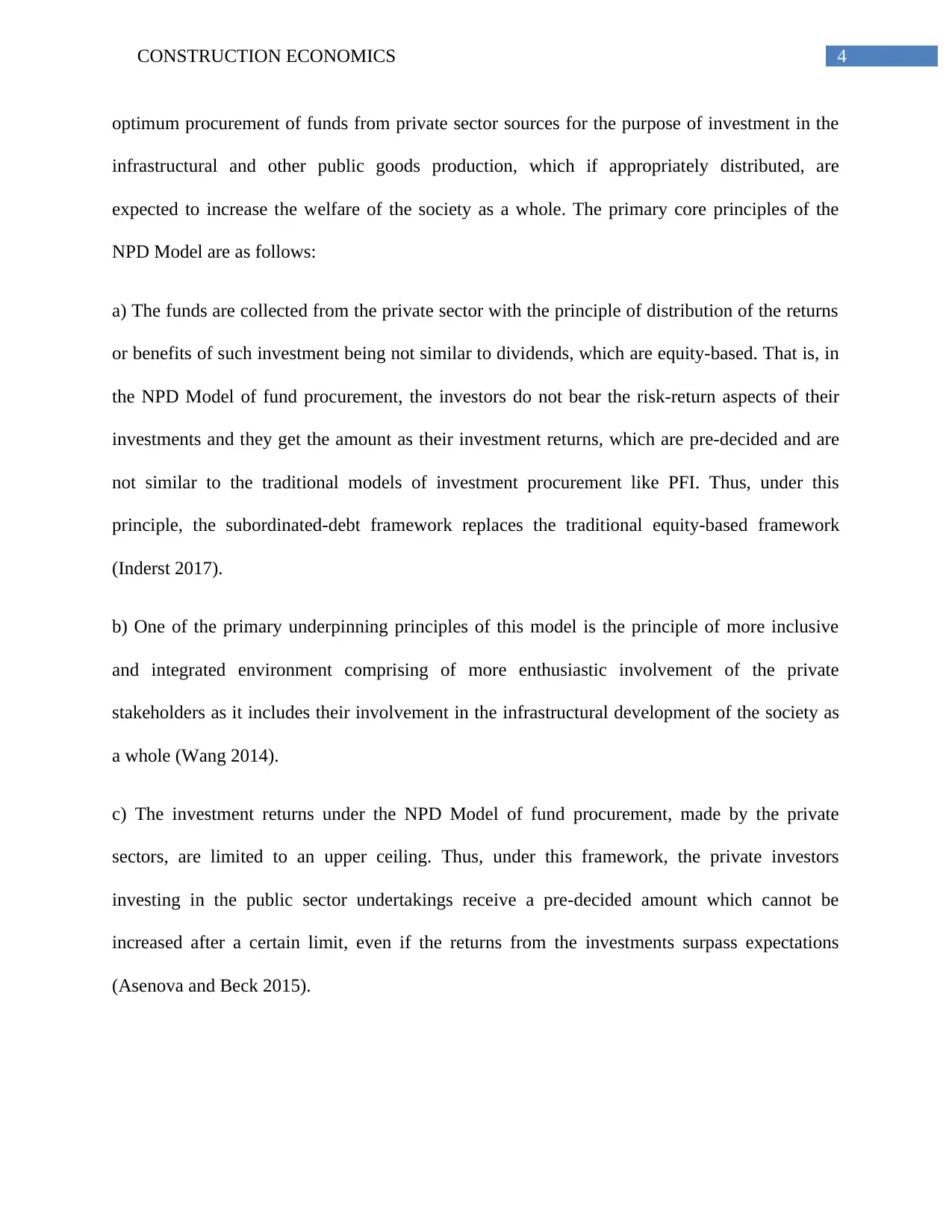
4CONSTRUCTION ECONOMICS
optimum procurement of funds from private sector sources for the purpose of investment in the
infrastructural and other public goods production, which if appropriately distributed, are
expected to increase the welfare of the society as a whole. The primary core principles of the
NPD Model are as follows:
a) The funds are collected from the private sector with the principle of distribution of the returns
or benefits of such investment being not similar to dividends, which are equity-based. That is, in
the NPD Model of fund procurement, the investors do not bear the risk-return aspects of their
investments and they get the amount as their investment returns, which are pre-decided and are
not similar to the traditional models of investment procurement like PFI. Thus, under this
principle, the subordinated-debt framework replaces the traditional equity-based framework
(Inderst 2017).
b) One of the primary underpinning principles of this model is the principle of more inclusive
and integrated environment comprising of more enthusiastic involvement of the private
stakeholders as it includes their involvement in the infrastructural development of the society as
a whole (Wang 2014).
c) The investment returns under the NPD Model of fund procurement, made by the private
sectors, are limited to an upper ceiling. Thus, under this framework, the private investors
investing in the public sector undertakings receive a pre-decided amount which cannot be
increased after a certain limit, even if the returns from the investments surpass expectations
(Asenova and Beck 2015).
optimum procurement of funds from private sector sources for the purpose of investment in the
infrastructural and other public goods production, which if appropriately distributed, are
expected to increase the welfare of the society as a whole. The primary core principles of the
NPD Model are as follows:
a) The funds are collected from the private sector with the principle of distribution of the returns
or benefits of such investment being not similar to dividends, which are equity-based. That is, in
the NPD Model of fund procurement, the investors do not bear the risk-return aspects of their
investments and they get the amount as their investment returns, which are pre-decided and are
not similar to the traditional models of investment procurement like PFI. Thus, under this
principle, the subordinated-debt framework replaces the traditional equity-based framework
(Inderst 2017).
b) One of the primary underpinning principles of this model is the principle of more inclusive
and integrated environment comprising of more enthusiastic involvement of the private
stakeholders as it includes their involvement in the infrastructural development of the society as
a whole (Wang 2014).
c) The investment returns under the NPD Model of fund procurement, made by the private
sectors, are limited to an upper ceiling. Thus, under this framework, the private investors
investing in the public sector undertakings receive a pre-decided amount which cannot be
increased after a certain limit, even if the returns from the investments surpass expectations
(Asenova and Beck 2015).
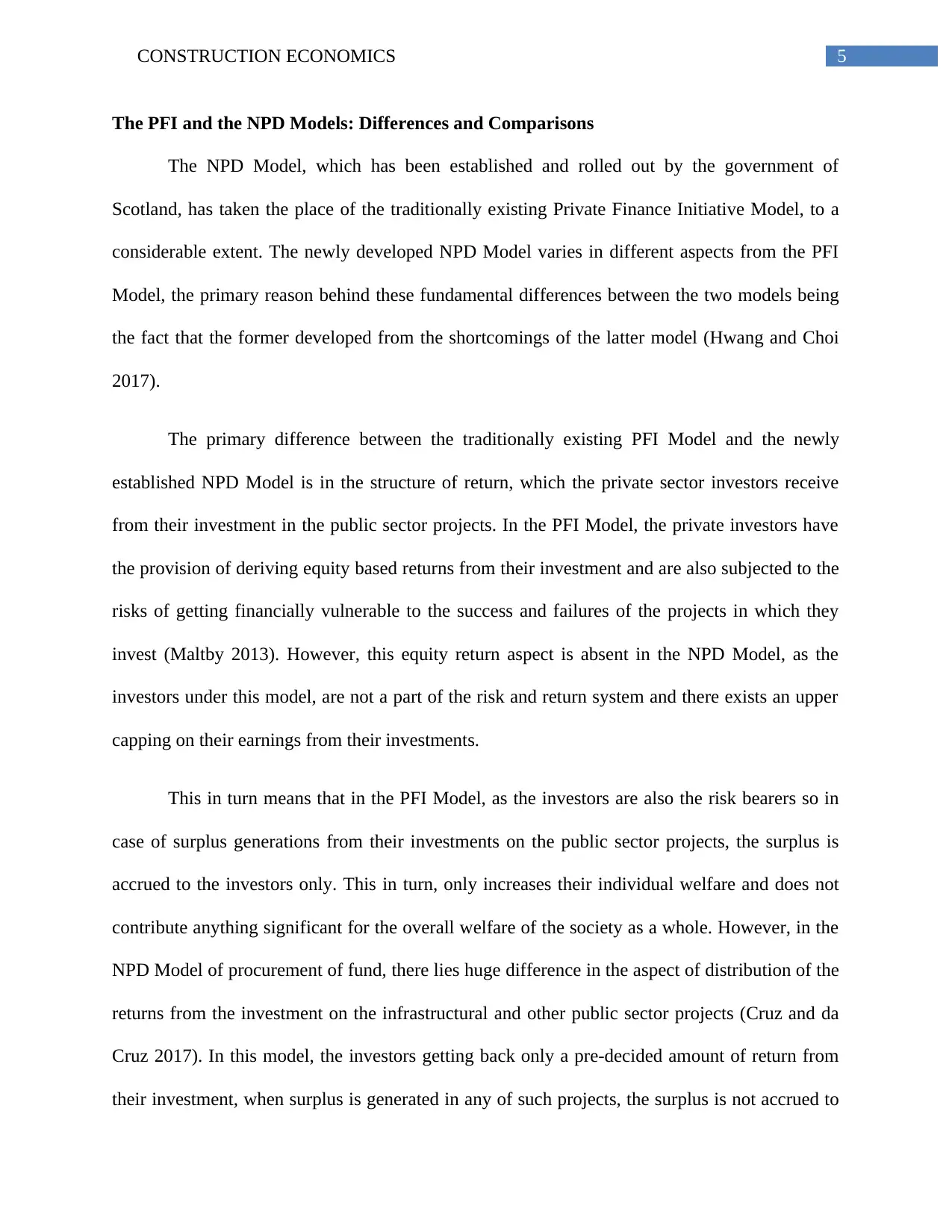
5CONSTRUCTION ECONOMICS
The PFI and the NPD Models: Differences and Comparisons
The NPD Model, which has been established and rolled out by the government of
Scotland, has taken the place of the traditionally existing Private Finance Initiative Model, to a
considerable extent. The newly developed NPD Model varies in different aspects from the PFI
Model, the primary reason behind these fundamental differences between the two models being
the fact that the former developed from the shortcomings of the latter model (Hwang and Choi
2017).
The primary difference between the traditionally existing PFI Model and the newly
established NPD Model is in the structure of return, which the private sector investors receive
from their investment in the public sector projects. In the PFI Model, the private investors have
the provision of deriving equity based returns from their investment and are also subjected to the
risks of getting financially vulnerable to the success and failures of the projects in which they
invest (Maltby 2013). However, this equity return aspect is absent in the NPD Model, as the
investors under this model, are not a part of the risk and return system and there exists an upper
capping on their earnings from their investments.
This in turn means that in the PFI Model, as the investors are also the risk bearers so in
case of surplus generations from their investments on the public sector projects, the surplus is
accrued to the investors only. This in turn, only increases their individual welfare and does not
contribute anything significant for the overall welfare of the society as a whole. However, in the
NPD Model of procurement of fund, there lies huge difference in the aspect of distribution of the
returns from the investment on the infrastructural and other public sector projects (Cruz and da
Cruz 2017). In this model, the investors getting back only a pre-decided amount of return from
their investment, when surplus is generated in any of such projects, the surplus is not accrued to
The PFI and the NPD Models: Differences and Comparisons
The NPD Model, which has been established and rolled out by the government of
Scotland, has taken the place of the traditionally existing Private Finance Initiative Model, to a
considerable extent. The newly developed NPD Model varies in different aspects from the PFI
Model, the primary reason behind these fundamental differences between the two models being
the fact that the former developed from the shortcomings of the latter model (Hwang and Choi
2017).
The primary difference between the traditionally existing PFI Model and the newly
established NPD Model is in the structure of return, which the private sector investors receive
from their investment in the public sector projects. In the PFI Model, the private investors have
the provision of deriving equity based returns from their investment and are also subjected to the
risks of getting financially vulnerable to the success and failures of the projects in which they
invest (Maltby 2013). However, this equity return aspect is absent in the NPD Model, as the
investors under this model, are not a part of the risk and return system and there exists an upper
capping on their earnings from their investments.
This in turn means that in the PFI Model, as the investors are also the risk bearers so in
case of surplus generations from their investments on the public sector projects, the surplus is
accrued to the investors only. This in turn, only increases their individual welfare and does not
contribute anything significant for the overall welfare of the society as a whole. However, in the
NPD Model of procurement of fund, there lies huge difference in the aspect of distribution of the
returns from the investment on the infrastructural and other public sector projects (Cruz and da
Cruz 2017). In this model, the investors getting back only a pre-decided amount of return from
their investment, when surplus is generated in any of such projects, the surplus is not accrued to
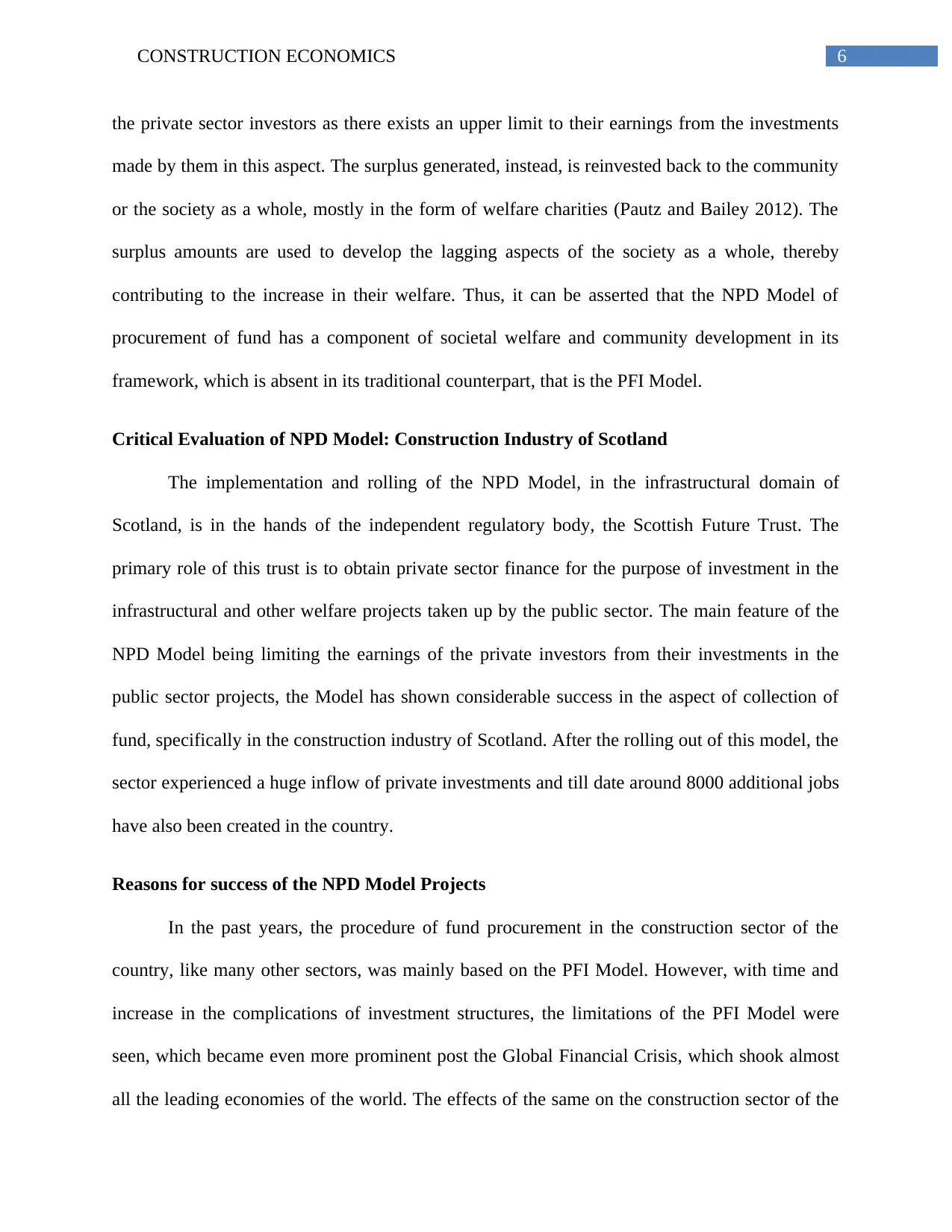
6CONSTRUCTION ECONOMICS
the private sector investors as there exists an upper limit to their earnings from the investments
made by them in this aspect. The surplus generated, instead, is reinvested back to the community
or the society as a whole, mostly in the form of welfare charities (Pautz and Bailey 2012). The
surplus amounts are used to develop the lagging aspects of the society as a whole, thereby
contributing to the increase in their welfare. Thus, it can be asserted that the NPD Model of
procurement of fund has a component of societal welfare and community development in its
framework, which is absent in its traditional counterpart, that is the PFI Model.
Critical Evaluation of NPD Model: Construction Industry of Scotland
The implementation and rolling of the NPD Model, in the infrastructural domain of
Scotland, is in the hands of the independent regulatory body, the Scottish Future Trust. The
primary role of this trust is to obtain private sector finance for the purpose of investment in the
infrastructural and other welfare projects taken up by the public sector. The main feature of the
NPD Model being limiting the earnings of the private investors from their investments in the
public sector projects, the Model has shown considerable success in the aspect of collection of
fund, specifically in the construction industry of Scotland. After the rolling out of this model, the
sector experienced a huge inflow of private investments and till date around 8000 additional jobs
have also been created in the country.
Reasons for success of the NPD Model Projects
In the past years, the procedure of fund procurement in the construction sector of the
country, like many other sectors, was mainly based on the PFI Model. However, with time and
increase in the complications of investment structures, the limitations of the PFI Model were
seen, which became even more prominent post the Global Financial Crisis, which shook almost
all the leading economies of the world. The effects of the same on the construction sector of the
the private sector investors as there exists an upper limit to their earnings from the investments
made by them in this aspect. The surplus generated, instead, is reinvested back to the community
or the society as a whole, mostly in the form of welfare charities (Pautz and Bailey 2012). The
surplus amounts are used to develop the lagging aspects of the society as a whole, thereby
contributing to the increase in their welfare. Thus, it can be asserted that the NPD Model of
procurement of fund has a component of societal welfare and community development in its
framework, which is absent in its traditional counterpart, that is the PFI Model.
Critical Evaluation of NPD Model: Construction Industry of Scotland
The implementation and rolling of the NPD Model, in the infrastructural domain of
Scotland, is in the hands of the independent regulatory body, the Scottish Future Trust. The
primary role of this trust is to obtain private sector finance for the purpose of investment in the
infrastructural and other welfare projects taken up by the public sector. The main feature of the
NPD Model being limiting the earnings of the private investors from their investments in the
public sector projects, the Model has shown considerable success in the aspect of collection of
fund, specifically in the construction industry of Scotland. After the rolling out of this model, the
sector experienced a huge inflow of private investments and till date around 8000 additional jobs
have also been created in the country.
Reasons for success of the NPD Model Projects
In the past years, the procedure of fund procurement in the construction sector of the
country, like many other sectors, was mainly based on the PFI Model. However, with time and
increase in the complications of investment structures, the limitations of the PFI Model were
seen, which became even more prominent post the Global Financial Crisis, which shook almost
all the leading economies of the world. The effects of the same on the construction sector of the
Paraphrase This Document
Need a fresh take? Get an instant paraphrase of this document with our AI Paraphraser
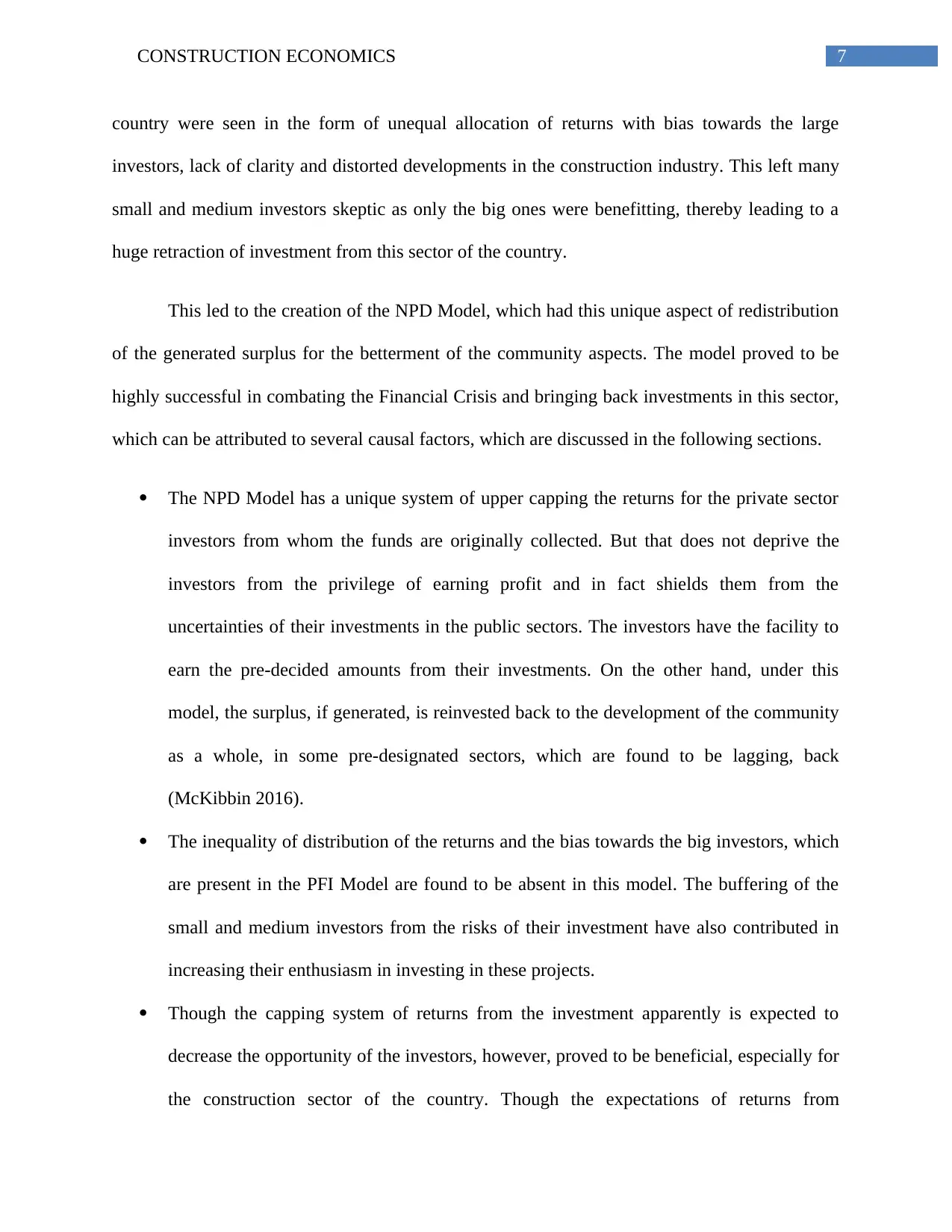
7CONSTRUCTION ECONOMICS
country were seen in the form of unequal allocation of returns with bias towards the large
investors, lack of clarity and distorted developments in the construction industry. This left many
small and medium investors skeptic as only the big ones were benefitting, thereby leading to a
huge retraction of investment from this sector of the country.
This led to the creation of the NPD Model, which had this unique aspect of redistribution
of the generated surplus for the betterment of the community aspects. The model proved to be
highly successful in combating the Financial Crisis and bringing back investments in this sector,
which can be attributed to several causal factors, which are discussed in the following sections.
The NPD Model has a unique system of upper capping the returns for the private sector
investors from whom the funds are originally collected. But that does not deprive the
investors from the privilege of earning profit and in fact shields them from the
uncertainties of their investments in the public sectors. The investors have the facility to
earn the pre-decided amounts from their investments. On the other hand, under this
model, the surplus, if generated, is reinvested back to the development of the community
as a whole, in some pre-designated sectors, which are found to be lagging, back
(McKibbin 2016).
The inequality of distribution of the returns and the bias towards the big investors, which
are present in the PFI Model are found to be absent in this model. The buffering of the
small and medium investors from the risks of their investment have also contributed in
increasing their enthusiasm in investing in these projects.
Though the capping system of returns from the investment apparently is expected to
decrease the opportunity of the investors, however, proved to be beneficial, especially for
the construction sector of the country. Though the expectations of returns from
country were seen in the form of unequal allocation of returns with bias towards the large
investors, lack of clarity and distorted developments in the construction industry. This left many
small and medium investors skeptic as only the big ones were benefitting, thereby leading to a
huge retraction of investment from this sector of the country.
This led to the creation of the NPD Model, which had this unique aspect of redistribution
of the generated surplus for the betterment of the community aspects. The model proved to be
highly successful in combating the Financial Crisis and bringing back investments in this sector,
which can be attributed to several causal factors, which are discussed in the following sections.
The NPD Model has a unique system of upper capping the returns for the private sector
investors from whom the funds are originally collected. But that does not deprive the
investors from the privilege of earning profit and in fact shields them from the
uncertainties of their investments in the public sectors. The investors have the facility to
earn the pre-decided amounts from their investments. On the other hand, under this
model, the surplus, if generated, is reinvested back to the development of the community
as a whole, in some pre-designated sectors, which are found to be lagging, back
(McKibbin 2016).
The inequality of distribution of the returns and the bias towards the big investors, which
are present in the PFI Model are found to be absent in this model. The buffering of the
small and medium investors from the risks of their investment have also contributed in
increasing their enthusiasm in investing in these projects.
Though the capping system of returns from the investment apparently is expected to
decrease the opportunity of the investors, however, proved to be beneficial, especially for
the construction sector of the country. Though the expectations of returns from
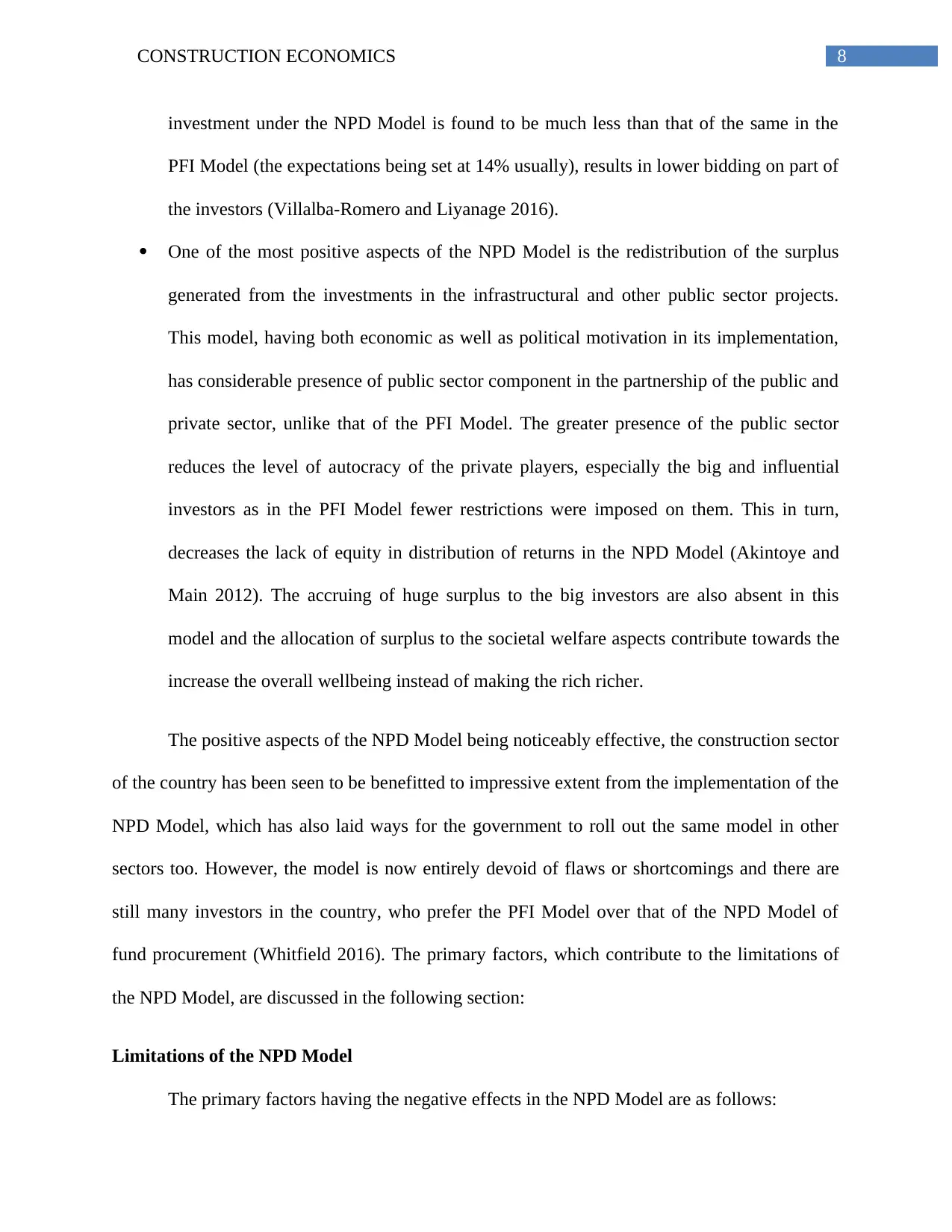
8CONSTRUCTION ECONOMICS
investment under the NPD Model is found to be much less than that of the same in the
PFI Model (the expectations being set at 14% usually), results in lower bidding on part of
the investors (Villalba-Romero and Liyanage 2016).
One of the most positive aspects of the NPD Model is the redistribution of the surplus
generated from the investments in the infrastructural and other public sector projects.
This model, having both economic as well as political motivation in its implementation,
has considerable presence of public sector component in the partnership of the public and
private sector, unlike that of the PFI Model. The greater presence of the public sector
reduces the level of autocracy of the private players, especially the big and influential
investors as in the PFI Model fewer restrictions were imposed on them. This in turn,
decreases the lack of equity in distribution of returns in the NPD Model (Akintoye and
Main 2012). The accruing of huge surplus to the big investors are also absent in this
model and the allocation of surplus to the societal welfare aspects contribute towards the
increase the overall wellbeing instead of making the rich richer.
The positive aspects of the NPD Model being noticeably effective, the construction sector
of the country has been seen to be benefitted to impressive extent from the implementation of the
NPD Model, which has also laid ways for the government to roll out the same model in other
sectors too. However, the model is now entirely devoid of flaws or shortcomings and there are
still many investors in the country, who prefer the PFI Model over that of the NPD Model of
fund procurement (Whitfield 2016). The primary factors, which contribute to the limitations of
the NPD Model, are discussed in the following section:
Limitations of the NPD Model
The primary factors having the negative effects in the NPD Model are as follows:
investment under the NPD Model is found to be much less than that of the same in the
PFI Model (the expectations being set at 14% usually), results in lower bidding on part of
the investors (Villalba-Romero and Liyanage 2016).
One of the most positive aspects of the NPD Model is the redistribution of the surplus
generated from the investments in the infrastructural and other public sector projects.
This model, having both economic as well as political motivation in its implementation,
has considerable presence of public sector component in the partnership of the public and
private sector, unlike that of the PFI Model. The greater presence of the public sector
reduces the level of autocracy of the private players, especially the big and influential
investors as in the PFI Model fewer restrictions were imposed on them. This in turn,
decreases the lack of equity in distribution of returns in the NPD Model (Akintoye and
Main 2012). The accruing of huge surplus to the big investors are also absent in this
model and the allocation of surplus to the societal welfare aspects contribute towards the
increase the overall wellbeing instead of making the rich richer.
The positive aspects of the NPD Model being noticeably effective, the construction sector
of the country has been seen to be benefitted to impressive extent from the implementation of the
NPD Model, which has also laid ways for the government to roll out the same model in other
sectors too. However, the model is now entirely devoid of flaws or shortcomings and there are
still many investors in the country, who prefer the PFI Model over that of the NPD Model of
fund procurement (Whitfield 2016). The primary factors, which contribute to the limitations of
the NPD Model, are discussed in the following section:
Limitations of the NPD Model
The primary factors having the negative effects in the NPD Model are as follows:
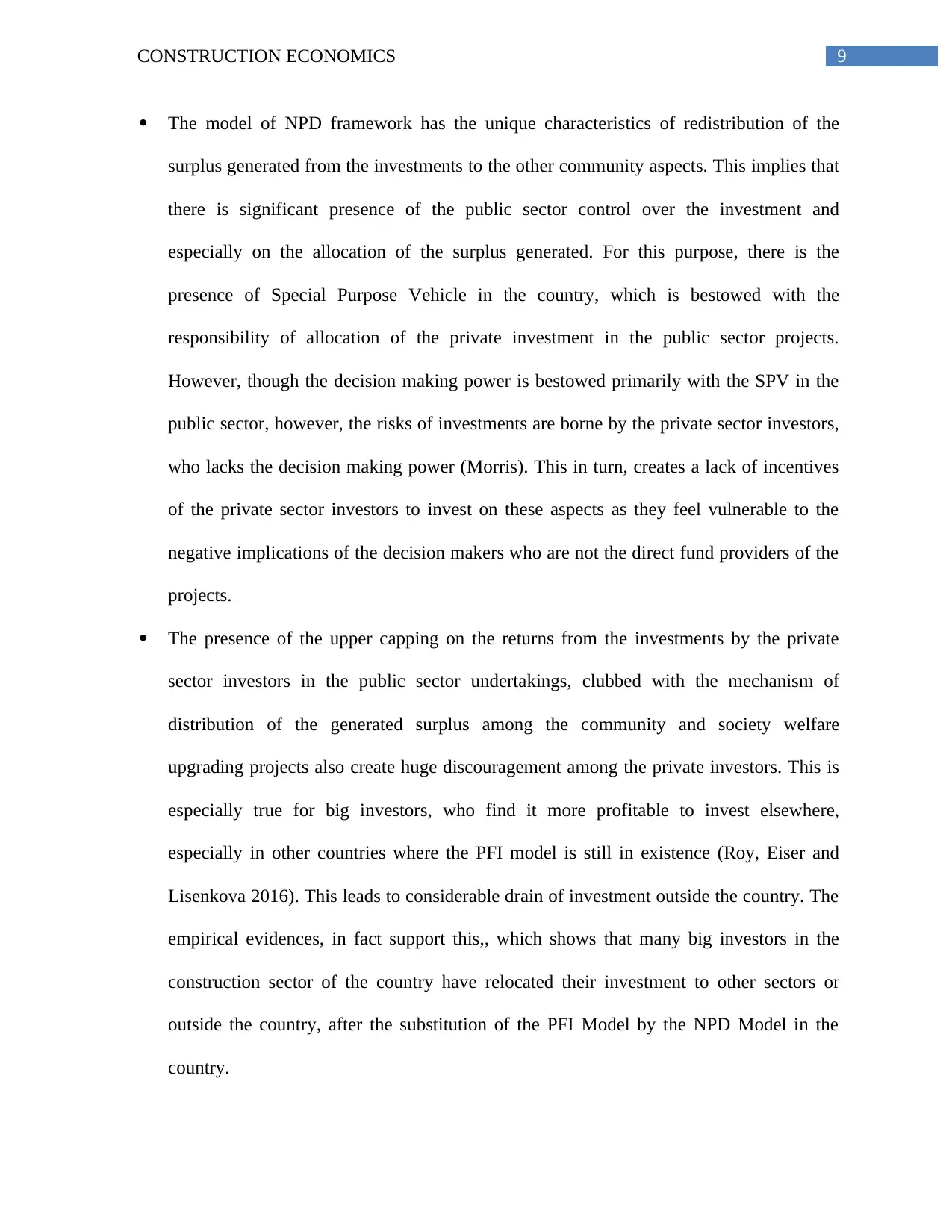
9CONSTRUCTION ECONOMICS
The model of NPD framework has the unique characteristics of redistribution of the
surplus generated from the investments to the other community aspects. This implies that
there is significant presence of the public sector control over the investment and
especially on the allocation of the surplus generated. For this purpose, there is the
presence of Special Purpose Vehicle in the country, which is bestowed with the
responsibility of allocation of the private investment in the public sector projects.
However, though the decision making power is bestowed primarily with the SPV in the
public sector, however, the risks of investments are borne by the private sector investors,
who lacks the decision making power (Morris). This in turn, creates a lack of incentives
of the private sector investors to invest on these aspects as they feel vulnerable to the
negative implications of the decision makers who are not the direct fund providers of the
projects.
The presence of the upper capping on the returns from the investments by the private
sector investors in the public sector undertakings, clubbed with the mechanism of
distribution of the generated surplus among the community and society welfare
upgrading projects also create huge discouragement among the private investors. This is
especially true for big investors, who find it more profitable to invest elsewhere,
especially in other countries where the PFI model is still in existence (Roy, Eiser and
Lisenkova 2016). This leads to considerable drain of investment outside the country. The
empirical evidences, in fact support this,, which shows that many big investors in the
construction sector of the country have relocated their investment to other sectors or
outside the country, after the substitution of the PFI Model by the NPD Model in the
country.
The model of NPD framework has the unique characteristics of redistribution of the
surplus generated from the investments to the other community aspects. This implies that
there is significant presence of the public sector control over the investment and
especially on the allocation of the surplus generated. For this purpose, there is the
presence of Special Purpose Vehicle in the country, which is bestowed with the
responsibility of allocation of the private investment in the public sector projects.
However, though the decision making power is bestowed primarily with the SPV in the
public sector, however, the risks of investments are borne by the private sector investors,
who lacks the decision making power (Morris). This in turn, creates a lack of incentives
of the private sector investors to invest on these aspects as they feel vulnerable to the
negative implications of the decision makers who are not the direct fund providers of the
projects.
The presence of the upper capping on the returns from the investments by the private
sector investors in the public sector undertakings, clubbed with the mechanism of
distribution of the generated surplus among the community and society welfare
upgrading projects also create huge discouragement among the private investors. This is
especially true for big investors, who find it more profitable to invest elsewhere,
especially in other countries where the PFI model is still in existence (Roy, Eiser and
Lisenkova 2016). This leads to considerable drain of investment outside the country. The
empirical evidences, in fact support this,, which shows that many big investors in the
construction sector of the country have relocated their investment to other sectors or
outside the country, after the substitution of the PFI Model by the NPD Model in the
country.
Secure Best Marks with AI Grader
Need help grading? Try our AI Grader for instant feedback on your assignments.
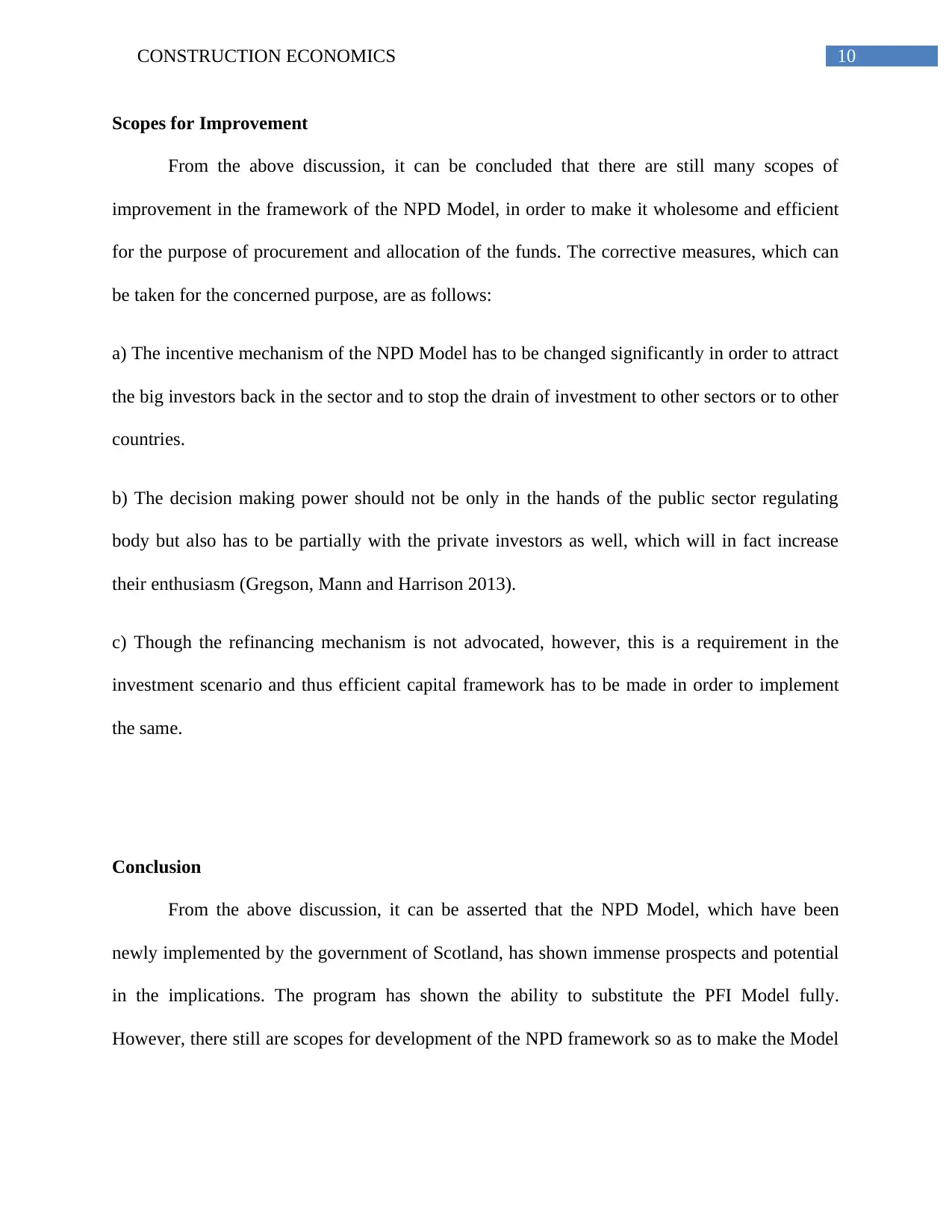
10CONSTRUCTION ECONOMICS
Scopes for Improvement
From the above discussion, it can be concluded that there are still many scopes of
improvement in the framework of the NPD Model, in order to make it wholesome and efficient
for the purpose of procurement and allocation of the funds. The corrective measures, which can
be taken for the concerned purpose, are as follows:
a) The incentive mechanism of the NPD Model has to be changed significantly in order to attract
the big investors back in the sector and to stop the drain of investment to other sectors or to other
countries.
b) The decision making power should not be only in the hands of the public sector regulating
body but also has to be partially with the private investors as well, which will in fact increase
their enthusiasm (Gregson, Mann and Harrison 2013).
c) Though the refinancing mechanism is not advocated, however, this is a requirement in the
investment scenario and thus efficient capital framework has to be made in order to implement
the same.
Conclusion
From the above discussion, it can be asserted that the NPD Model, which have been
newly implemented by the government of Scotland, has shown immense prospects and potential
in the implications. The program has shown the ability to substitute the PFI Model fully.
However, there still are scopes for development of the NPD framework so as to make the Model
Scopes for Improvement
From the above discussion, it can be concluded that there are still many scopes of
improvement in the framework of the NPD Model, in order to make it wholesome and efficient
for the purpose of procurement and allocation of the funds. The corrective measures, which can
be taken for the concerned purpose, are as follows:
a) The incentive mechanism of the NPD Model has to be changed significantly in order to attract
the big investors back in the sector and to stop the drain of investment to other sectors or to other
countries.
b) The decision making power should not be only in the hands of the public sector regulating
body but also has to be partially with the private investors as well, which will in fact increase
their enthusiasm (Gregson, Mann and Harrison 2013).
c) Though the refinancing mechanism is not advocated, however, this is a requirement in the
investment scenario and thus efficient capital framework has to be made in order to implement
the same.
Conclusion
From the above discussion, it can be asserted that the NPD Model, which have been
newly implemented by the government of Scotland, has shown immense prospects and potential
in the implications. The program has shown the ability to substitute the PFI Model fully.
However, there still are scopes for development of the NPD framework so as to make the Model

11CONSTRUCTION ECONOMICS
more efficient as well as beneficial for the society as well as for the investors and their overall
welfare.
more efficient as well as beneficial for the society as well as for the investors and their overall
welfare.
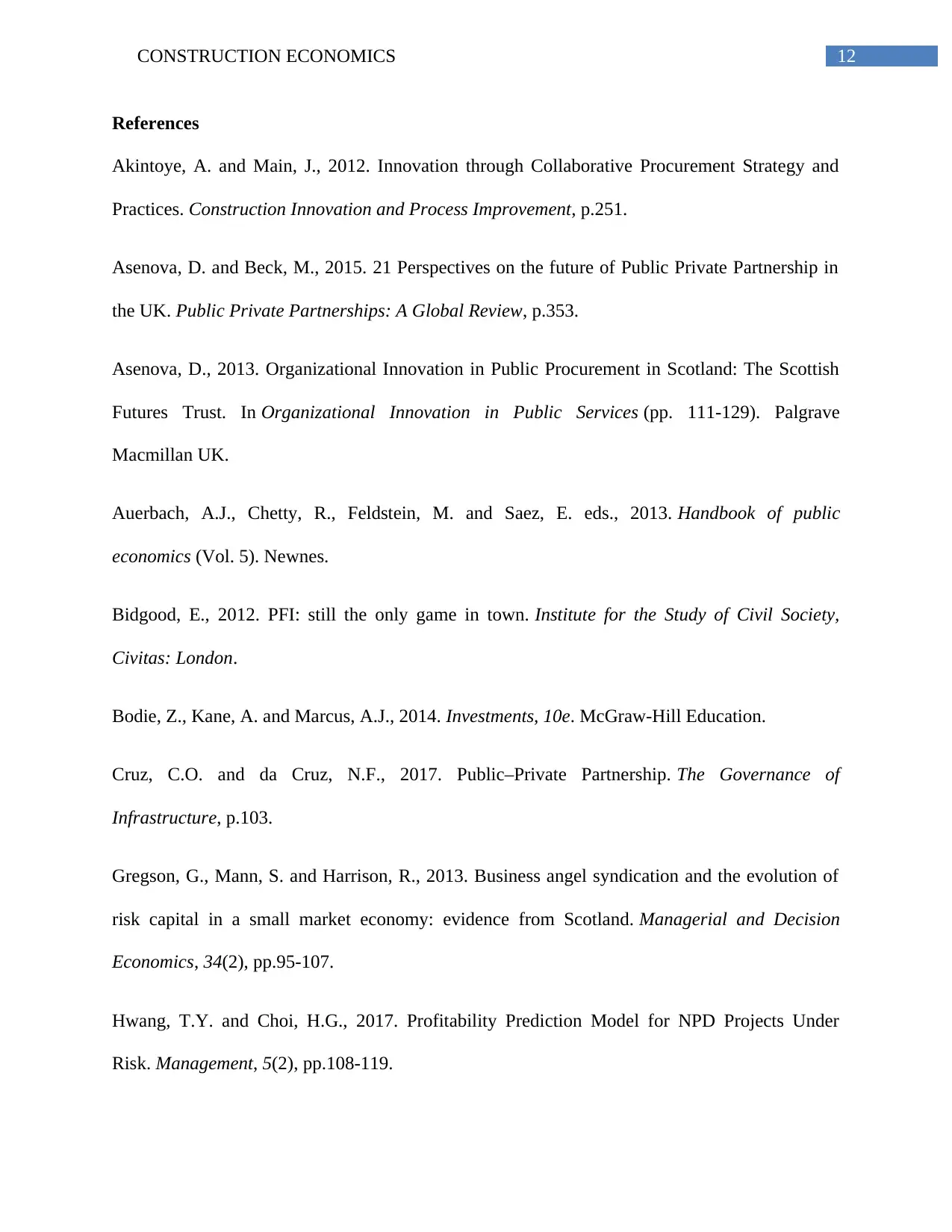
12CONSTRUCTION ECONOMICS
References
Akintoye, A. and Main, J., 2012. Innovation through Collaborative Procurement Strategy and
Practices. Construction Innovation and Process Improvement, p.251.
Asenova, D. and Beck, M., 2015. 21 Perspectives on the future of Public Private Partnership in
the UK. Public Private Partnerships: A Global Review, p.353.
Asenova, D., 2013. Organizational Innovation in Public Procurement in Scotland: The Scottish
Futures Trust. In Organizational Innovation in Public Services (pp. 111-129). Palgrave
Macmillan UK.
Auerbach, A.J., Chetty, R., Feldstein, M. and Saez, E. eds., 2013. Handbook of public
economics (Vol. 5). Newnes.
Bidgood, E., 2012. PFI: still the only game in town. Institute for the Study of Civil Society,
Civitas: London.
Bodie, Z., Kane, A. and Marcus, A.J., 2014. Investments, 10e. McGraw-Hill Education.
Cruz, C.O. and da Cruz, N.F., 2017. Public–Private Partnership. The Governance of
Infrastructure, p.103.
Gregson, G., Mann, S. and Harrison, R., 2013. Business angel syndication and the evolution of
risk capital in a small market economy: evidence from Scotland. Managerial and Decision
Economics, 34(2), pp.95-107.
Hwang, T.Y. and Choi, H.G., 2017. Profitability Prediction Model for NPD Projects Under
Risk. Management, 5(2), pp.108-119.
References
Akintoye, A. and Main, J., 2012. Innovation through Collaborative Procurement Strategy and
Practices. Construction Innovation and Process Improvement, p.251.
Asenova, D. and Beck, M., 2015. 21 Perspectives on the future of Public Private Partnership in
the UK. Public Private Partnerships: A Global Review, p.353.
Asenova, D., 2013. Organizational Innovation in Public Procurement in Scotland: The Scottish
Futures Trust. In Organizational Innovation in Public Services (pp. 111-129). Palgrave
Macmillan UK.
Auerbach, A.J., Chetty, R., Feldstein, M. and Saez, E. eds., 2013. Handbook of public
economics (Vol. 5). Newnes.
Bidgood, E., 2012. PFI: still the only game in town. Institute for the Study of Civil Society,
Civitas: London.
Bodie, Z., Kane, A. and Marcus, A.J., 2014. Investments, 10e. McGraw-Hill Education.
Cruz, C.O. and da Cruz, N.F., 2017. Public–Private Partnership. The Governance of
Infrastructure, p.103.
Gregson, G., Mann, S. and Harrison, R., 2013. Business angel syndication and the evolution of
risk capital in a small market economy: evidence from Scotland. Managerial and Decision
Economics, 34(2), pp.95-107.
Hwang, T.Y. and Choi, H.G., 2017. Profitability Prediction Model for NPD Projects Under
Risk. Management, 5(2), pp.108-119.
Paraphrase This Document
Need a fresh take? Get an instant paraphrase of this document with our AI Paraphraser
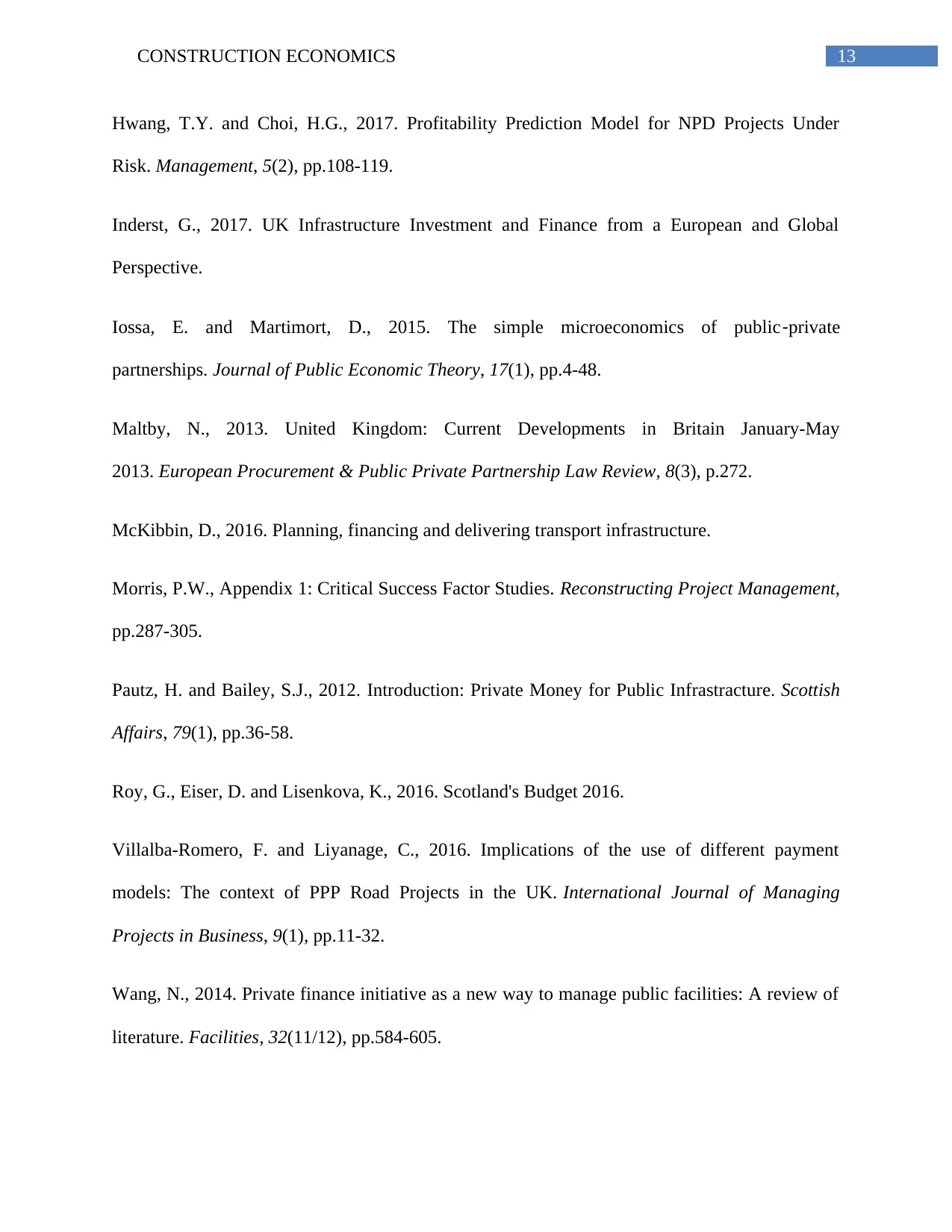
13CONSTRUCTION ECONOMICS
Hwang, T.Y. and Choi, H.G., 2017. Profitability Prediction Model for NPD Projects Under
Risk. Management, 5(2), pp.108-119.
Inderst, G., 2017. UK Infrastructure Investment and Finance from a European and Global
Perspective.
Iossa, E. and Martimort, D., 2015. The simple microeconomics of public‐private
partnerships. Journal of Public Economic Theory, 17(1), pp.4-48.
Maltby, N., 2013. United Kingdom: Current Developments in Britain January-May
2013. European Procurement & Public Private Partnership Law Review, 8(3), p.272.
McKibbin, D., 2016. Planning, financing and delivering transport infrastructure.
Morris, P.W., Appendix 1: Critical Success Factor Studies. Reconstructing Project Management,
pp.287-305.
Pautz, H. and Bailey, S.J., 2012. Introduction: Private Money for Public Infrastracture. Scottish
Affairs, 79(1), pp.36-58.
Roy, G., Eiser, D. and Lisenkova, K., 2016. Scotland's Budget 2016.
Villalba-Romero, F. and Liyanage, C., 2016. Implications of the use of different payment
models: The context of PPP Road Projects in the UK. International Journal of Managing
Projects in Business, 9(1), pp.11-32.
Wang, N., 2014. Private finance initiative as a new way to manage public facilities: A review of
literature. Facilities, 32(11/12), pp.584-605.
Hwang, T.Y. and Choi, H.G., 2017. Profitability Prediction Model for NPD Projects Under
Risk. Management, 5(2), pp.108-119.
Inderst, G., 2017. UK Infrastructure Investment and Finance from a European and Global
Perspective.
Iossa, E. and Martimort, D., 2015. The simple microeconomics of public‐private
partnerships. Journal of Public Economic Theory, 17(1), pp.4-48.
Maltby, N., 2013. United Kingdom: Current Developments in Britain January-May
2013. European Procurement & Public Private Partnership Law Review, 8(3), p.272.
McKibbin, D., 2016. Planning, financing and delivering transport infrastructure.
Morris, P.W., Appendix 1: Critical Success Factor Studies. Reconstructing Project Management,
pp.287-305.
Pautz, H. and Bailey, S.J., 2012. Introduction: Private Money for Public Infrastracture. Scottish
Affairs, 79(1), pp.36-58.
Roy, G., Eiser, D. and Lisenkova, K., 2016. Scotland's Budget 2016.
Villalba-Romero, F. and Liyanage, C., 2016. Implications of the use of different payment
models: The context of PPP Road Projects in the UK. International Journal of Managing
Projects in Business, 9(1), pp.11-32.
Wang, N., 2014. Private finance initiative as a new way to manage public facilities: A review of
literature. Facilities, 32(11/12), pp.584-605.

14CONSTRUCTION ECONOMICS
Whitfield, D., 2016. The financial commodification of public infrastructure. European Services
Strategy Unit: Research Report, (8).
Whitfield, D., 2016. The financial commodification of public infrastructure. European Services
Strategy Unit: Research Report, (8).
1 out of 15
Related Documents
Your All-in-One AI-Powered Toolkit for Academic Success.
+13062052269
info@desklib.com
Available 24*7 on WhatsApp / Email
![[object Object]](/_next/static/media/star-bottom.7253800d.svg)
Unlock your academic potential
© 2024 | Zucol Services PVT LTD | All rights reserved.





